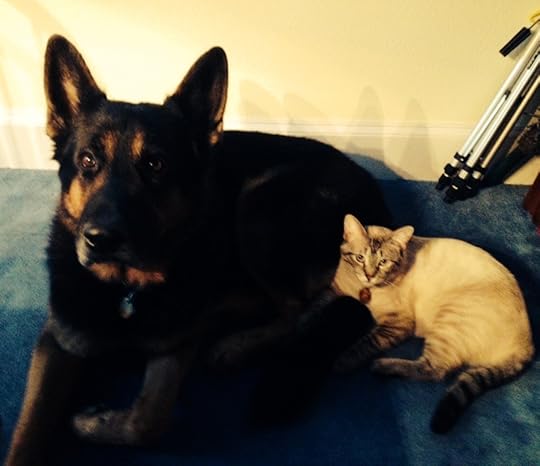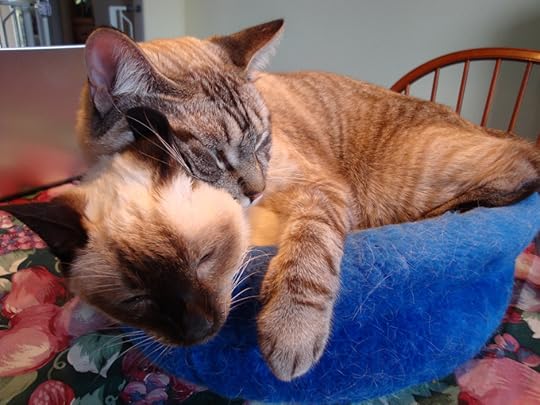Amy Shojai's Blog, page 87
October 20, 2015
Adopt A Dog Month: #BigLove Adoption Pledge
 There are many ways people find the dog of their heart…some folks find a needy stray, others research and work to get on a waiting list for their true puppy love, still others rescue. One of the best places to find “second hand dogs” that become your “best in show” pick is your local shelter.
There are many ways people find the dog of their heart…some folks find a needy stray, others research and work to get on a waiting list for their true puppy love, still others rescue. One of the best places to find “second hand dogs” that become your “best in show” pick is your local shelter.
The puppies, and the cute small dogs have an advantage. I’m all for them getting homes, of course…but it’s the BIG dogs that seem to languish, despite having love as big as their hearts. So this year, the ASPCA’s push is to get some attention to the BIG DOGS!
 Magical-Dawg thinks that’s PAW-some! So does Karma-Kat, who believes big dogs ROCK. Seren-Kitty (below) …meh, she’s not convinced any critter should share her home, LOL! But I’m here ta tell you that cats and BIG DOGS can be a beautiful thing.
Magical-Dawg thinks that’s PAW-some! So does Karma-Kat, who believes big dogs ROCK. Seren-Kitty (below) …meh, she’s not convinced any critter should share her home, LOL! But I’m here ta tell you that cats and BIG DOGS can be a beautiful thing.
Last week the blog covered lots of cat-centric topics to prevent cat fights as well as help feral felines, so it’s only fair to give equal time to dogs this week. We’re equal opportunity pet lovers here, and have a particular fondness for the big doggies. That’s only one reason my next thriller features some of the neato-torpedo bestest (and most misunderstood) big dogs around: Pit Bulls.
Each year, the ASPCA promotes October as Adopt a Shelter Dog Month to showcase the millions of gorgeous and worthy dogs who enter shelters each year. For 2015, the ASPCA is raising awareness by partnering with Animal Planet with a social media contest celebrating shelter dogs.
 To help bring attention to adoptables during this special month, the ASPCA is doing a big push this year encouraging folks to consider adopting a big dog by running a #BigLove campaign which centers around the idea that it’s not the size of your home, it’s the size of your heart that matters.
To help bring attention to adoptables during this special month, the ASPCA is doing a big push this year encouraging folks to consider adopting a big dog by running a #BigLove campaign which centers around the idea that it’s not the size of your home, it’s the size of your heart that matters.
For the contest, say why you think BIG dogs rock to be entered to win a pair of ASPCA Party Animal Pillows from PBteen. And if you’re a proud parent of a bigger-sized dog, please share their photo on social media using the hashtag #BigLove and tagging @ASPCA and they’ll share a few favorites!
Share photos of your shelter dog at www.aspca.org/MyRescueDog to be entered. Visit www.aspca.org/BigLove if you also believe it’s not the size of your home but the size of your heart that matters! Ready…set…GO!
 SHOW AND TELL, COMING SOON! An animal behaviorist and her service dog race a deadly storm to expose a treacherous secret others will kill to protect.
SHOW AND TELL, COMING SOON! An animal behaviorist and her service dog race a deadly storm to expose a treacherous secret others will kill to protect.
I love hearing from you, so please share comments and questions. Do you have an ASK AMY question you’d like answered–click the banner, above. Be sure to visit my PetHealthyStore for paw-some products for your furry wonders! Stay up to date on all the latest just subscribe the blog, “like” me on Facebook,and get a FREE BOOK when you sign up for Pet Peeves newsletter. Want the insider info on the latest books and appearances? Join my team and get advance sneak peaks related to my THRILLERS WITH BITE!
October 16, 2015
Feral Cats, Our Responsiblity

When I adopted Seren, she also suffered from patches of hair loss from ringworm.
October 16 is National Feral Cat Day. North Texas is home to quite a large population of ferals–wild felines–that would benefit from a formal TNR program.
This is very close to my heart because 20 years ago, Seren-Kitty was dumped on the streets, and then two years ago Karma met the same fate. Had I not found and adopted them, their lives would have been much different.
 Feral cats live life on the fringes. They breed, give birth, and raise kittens with little to no human contact. These are not pet cats gone wild (strays)–they are wild animals that really cannot be tamed unless caught as kittens. Even then, they may never be a typical pet cat, but face behavior challenges all their life.
Feral cats live life on the fringes. They breed, give birth, and raise kittens with little to no human contact. These are not pet cats gone wild (strays)–they are wild animals that really cannot be tamed unless caught as kittens. Even then, they may never be a typical pet cat, but face behavior challenges all their life.
Why should we care? Because if not managed properly, feral cats become a nuisance and health risk to owned cats, and even humans. Felines squabbling outside your window wind up your owned indoor cats and can result in cat fights, as I described in this post about cat fighs. Caring for ferals is also the ethical, humane thing for caring people to do.
What can be done? TNR has become the gold standard for managing feral cats. The acronym stands for “trap-neuter-return,” a program designed to control and decrease the numbers of roaming felines. TNR first appeared in Europe, and became better known once animal welfare societies in Great Britain began advocating the approach more than 30 years ago.
 Louise Holton, an early proponent, first learned of TNR in the mid-1970s while living in South Africa. Once she moved to America, Holton founded Alley Cat Allies (ACA) in 1990 as an educational resource for humane methods of feral cat control.
Louise Holton, an early proponent, first learned of TNR in the mid-1970s while living in South Africa. Once she moved to America, Holton founded Alley Cat Allies (ACA) in 1990 as an educational resource for humane methods of feral cat control.
Today, ACA is arguably the best organized of many such organizations and provides incredible support and information to cat lovers wanting to “do the right thing” for the feral felines in their communities. About 70% of cats who enter shelters are killed there, including virtually 100% of feral cats. That’s one reason so many people (up to 10 percent of people in the United States) have fed a stray or feral cat. People care–they often just aren’t sure what to do or where to find help. And simply setting out food only “feeds” the problem, it doesn’t manage or control the situation. But TNR does. I’ve written more extensively about the issue here.

A group of feral cats huddled together to keep warm, near the wall of an old abandoned home. Taken during -28C weather.
Trapped cats receive a health exam to identify very sick cats, which are humanely euthanized. That prevents the spread of disease. Healthy kitties are sterilized and vaccinated, to prevent reproduction or illnesses such as rabies.
Tame-able kittens are adopted while the wild adults live out their lives–sometimes a decade or longer–in the managed colony. Without vaccinations and sterilization, the cats’ lifespans would be much shorter, and they’d produce many more sick kittens destined to repeat the cycle. The removal of one ear tip identifies these cats as managed. The caregiver(s) monitor the colony and provides food and shelter.
Not everyone is a fan. People dislike the noise and mess of roaming cats, and the potential for disease such as rabies. They also may not want to spend funds on wild cats. But alternatives are more expensive.
 Feral cats can rarely be tamed or easily contained by fences. Sanctuaries and shelters fill up too quickly and ferals are not good candidates for adoption–most would be euthanized if taken to the shelter.
Feral cats can rarely be tamed or easily contained by fences. Sanctuaries and shelters fill up too quickly and ferals are not good candidates for adoption–most would be euthanized if taken to the shelter.
Simply removing cats from the area that offers shelter and food won’t work. Once the original kitties are gone, other feral cats simply move back into that niche–a “vacuum effect.” But if you maintain the colony and keep it healthy and unable to reproduce, the ferals in the colony keep other cats out. Trap and kill programs have been tried–they were expensive and didn’t work because of this vacuum effect. Besides, most Americans dislike the notion of treating cats as vermin.
Alley Cat Allies and other educational resources have made great strides in educating the public about feral cat solutions. People on both sides of the TNR fence agree that owned cats should be sterilized and identified, and safely confined in some way.
Feral cat programs have impacted our world in an intangible but perhaps even more important way. TNR demonstrates that all cats have a value, even those that can’t be touched. We as human beings now recognized our ethical responsibility toward these community cats and that they should be cared for and treated humanely.
So what are you doing on October 16, National Feral Cat Day? Have you ever feed a “community cat” or adopted one? Does your community have a TNR program in place…or needs one?
I love hearing from you, so please share comments and questions. Do you have an ASK AMY question you’d like answered–click the banner, above. Be sure to visit my PetHealthyStore for paw-some products for your furry wonders! Stay up to date on all the latest just subscribe the blog, “like” me on Facebook,and get a FREE BOOK when you sign up for Pet Peeves newsletter. Want the insider info on the latest books and appearances? Join my team and get advance sneak peaks related to my THRILLERS WITH BITE!
October 12, 2015
Cat Fight! What to Do
Karma-Kat and Seren-Kitty engage in what appears to be a cat fight on almost a daily basis. From Karma’s standpoint, he wants to wrestle and play. Seren is not amused, and starts yowling at him to “back off, buster!” at the first hint he’s strolling her direction. Here’s the deal, though…no fur flies, nobody is injured, and Seren always comes back for more.
Thank cod! 
 Cats usually work out their social standing with posturing and kitty bluffs, and neither kitty gets hurt. However, the lowest ranking cat (often an older, or ill kitty like Seren) can become a target picked on by the other felines. Acting like a victim (slinking around, using submissive body language, hiding) is the equivalent of wearing a “kick me” sign and invites bullies to increase their bluster. Karma weighs more than twice as much as Seren’s 6-lb frame, and at 19 years old, my little Siamese wannabe has become quite frail. So these days, Karma spends time with Magic in my office while I work, and Seren gets some much appreciated alone time.
Cats usually work out their social standing with posturing and kitty bluffs, and neither kitty gets hurt. However, the lowest ranking cat (often an older, or ill kitty like Seren) can become a target picked on by the other felines. Acting like a victim (slinking around, using submissive body language, hiding) is the equivalent of wearing a “kick me” sign and invites bullies to increase their bluster. Karma weighs more than twice as much as Seren’s 6-lb frame, and at 19 years old, my little Siamese wannabe has become quite frail. So these days, Karma spends time with Magic in my office while I work, and Seren gets some much appreciated alone time.
 Cat-on-cat fights can result from any other kind, such as redirected aggression, play aggression, and fear aggression. Most intercat aggression involves intact same-gender cats, and gets worse during mating season. That’s why spaying or neutering before a year old decreases or prevents about 90 percent of intercat aggression.
Cat-on-cat fights can result from any other kind, such as redirected aggression, play aggression, and fear aggression. Most intercat aggression involves intact same-gender cats, and gets worse during mating season. That’s why spaying or neutering before a year old decreases or prevents about 90 percent of intercat aggression.
WHY CATS FIGHT
The top reason for cat fights is improper introductions. It’s a cat “rule” that a strange cat should be kicked out of the territory, so just dumping the newbie in with your crew asks for trouble. Once cats experience an altercation, that can predispose them to future fights because the experience was so unpleasant, scary, painful, etc. Think of it this way: the more cats “practice” being aggressive, the more likely they are to simply trigger into a fight at each others’ presence.
Sometimes cats get along fine, until suddenly they don’t. That leaves us wondering, what happened? Often this is because cats reach social maturity at two to four years of age when many cats first challenge others for status.
Changes to the cat’s social group (new cat arrives or familiar cat dies/leaves) can prompt an increase in face-offs. Environmental changes such as moving or rearranging cat furniture or feeding/bathroom stations, also can cause the fur to fly. Basically, any change in the routine may leave one or more cats so stressed they take it out on each other.
Not enough space predisposes cats to territorial disputes. Cats mark property with cheek rubs, patrolling, and urine marking. Some diabolical felines lure others into their territory and then “discipline” the other cat for trespassing. Feline territorial aggression is notoriously hard to correct, and marking behavior is a hallmark of potential aggression. Outdoor cats are more aggressive on their home turf and the cat closest to home usually wins the dispute.
SIGNS OF CAT AGGRESSION
It’s not all about hissing, screaming and wrestling. Cats use lots of subtle behaviors to control space. I call it “kitty poker” and in the best of all possible worlds, one cat backs down without a fight, and life goes on. Because it’s so subtle, though, you may not recognize power plays until one cat’s had enough and launches into a full-on cat fight.
Cats use verbal and silent communication to elevate their status in the eyes of the other felines. They challenge each other with stares, forward-facing body position, hisses and growls, mounting behavior and nape bites, or blocking access to food, play, or attention. Some dominant cats use “power grooming” behavior—energetically licking the other cat—to make her move away.
 Karma simply lies down on top of Seren, sort of a Sumo-Kitty move that makes her crazy and prompts her to give up her preferred bed. Yes, Karma’s a bit of a bully.
Karma simply lies down on top of Seren, sort of a Sumo-Kitty move that makes her crazy and prompts her to give up her preferred bed. Yes, Karma’s a bit of a bully.
Never allow cats to “fight it out” as that rarely settles conflicts but makes matters worse. Manage with behavior modification, counter-conditioning, and sometimes drug therapy. The 10 tips below can help ease the strain and in some instances resolve intercat aggression.
10 TIPS TO PREVENT CAT FIGHTS
Reduce the urge to fight by adding more territorial space so the cats don’t have to share climbing, hiding, and perching areas. Create a house of plenty with MORE toys, cat trees, litter boxes and feeding stations than the cats can use all at once.
Electronic cat doors that can only be opened by the collared victim cat will allow her to access the entire home yet retreat to a safe area the aggressor can’t follow. These pet doors open in response to the magnetic “key” inside the collar. Look for “keyed” pet doors at pet products stores or on the Internet.
Avoid rewarding poor behavior. For instance, giving food or attention to the aggressive cat may calm the angst but actually pays her to be a bully. Instead, catch Sheba before she gets hissy and redirect her behavior with an interactive toy, such as a flashlight beam, to lure her into play in another direction. That can also help her associate good things with the other cat—rather than with being nasty.
If the toy doesn’t work, interrupt with an aerosol hiss. Then once the cat walks away and is calm, reinforce the desirable response—acting calm—by offering a treat, toy or attention.
Go back to basics and treat the aggressive cats as though introducing them for the first time. It’s best to give the victim cat the choice location of the house, and sequester the bully cat in the isolation room.
If you see no significant improvement within a week, talk with a veterinary behaviorist to see if drug therapy may be helpful. Drugs may help control the aggressive behavior in the bully cat, while decreasing the “kick me” defensive posturing and vocalizing of the threatened cat. Drugs aren’t a cure, but can be a tool that helps training work more effectively.
Once the signs of aggression, anxiety, and/or hyper-vigilance fade, begin to gradually expose the cats to each other in very controlled situations. Begin with the cats in carriers, or controlled with a harness and leash, at opposite ends of your largest room or longest hallway.
During each session feed cats tasty foods or engage in play. This helps both cats learn to associate each other with fun, positive rewards.
Interrupt unacceptable behavior (hisses, growls) with a squirt of compressed air or water gun, and toss small stinky treats to reinforce “good” (calm) behavior. Counter conditioning can take months and require much patience and time.
Once cats have learned to tolerate each other and are allowed to freely roam, create at least two feeding stations and two bathroom locations but the 1 1 rule is even better (one for each cat, plus one). Locate them so cats won’t be trapped or surprised when using either.
Thunder and fury with no blood spilled indicates they have excellent bite inhibition but few fights resulting in lots of damage indicate that at least one of the cats either has very poor inhibitions, or seriously wants to kill the other cat. Cats that hate each other and draw blood during fights have an extremely poor prognosis. When all tactics have failed to stop two indoor cats from fighting, then ultimately one cat may need to be placed in a new home or permanently segregated from the other in another part of the house. That’s NOT giving up—it’s making life better for the cats, and you.
Do your cats squabble? How do you manage the disputes?
I love hearing from you, so please share comments and questions. Do you have an ASK AMY question you’d like answered–click the banner, above. Be sure to visit my PetHealthyStore for paw-some products for your furry wonders! Stay up to date on all the latest just subscribe the blog, “like” me on Facebook,and get a FREE BOOK when you sign up for Pet Peeves newsletter. Want the insider info on the latest books and appearances? Join my team and get advance sneak peaks related to my THRILLERS WITH BITE!
October 9, 2015
Pit Bulls, Rottweilers, Facts & Fiction
 Busy busy busy…just wanted to update everyone on the FICTIONING front, as well as about other projects. I turned in first pass edits last Saturday and hope to soon have a publication date on SHOW AND TELL, woot! Once the book is ARC-ready, my Triple A team will get first dibs on reading previews. I’m hoping to have pre-orders up by the end of the month.
Busy busy busy…just wanted to update everyone on the FICTIONING front, as well as about other projects. I turned in first pass edits last Saturday and hope to soon have a publication date on SHOW AND TELL, woot! Once the book is ARC-ready, my Triple A team will get first dibs on reading previews. I’m hoping to have pre-orders up by the end of the month.
Wouldn’t it be cool to have preorders open up on National Pit Bull Awareness Day on October 24?
This weekend I’m finishing up the bonus chapter featuring the
And, I’ve decided to also incorporate in that chapter the main characters to my forthcoming Lei Crime KindleWorlds novella (which will also include “dog POV” . . . actually a Rottie puppy POV!). Read about that here.
 I still need to get high quality photos of the Name That Dog/Cat contest winners, in order to put together the promo poster I promised, so I’ll be reaching out to those folks soon. And…if I can manage to squeeze this in as well, I’ll have a book trailer that includes an original song for folks to share.
I still need to get high quality photos of the Name That Dog/Cat contest winners, in order to put together the promo poster I promised, so I’ll be reaching out to those folks soon. And…if I can manage to squeeze this in as well, I’ll have a book trailer that includes an original song for folks to share.
Did I mention BUSY?!
I’m also in the process of completing my next two nonfiction books–I’ve already shared details about these books, as well as sample covers, with my Triple A Team, and will be sharing this next week with my Pet Peeves newsletter subscribers so sign up now if you want a sneak peak! Hoping to have these books out in time for the holidays:
CAT FACTS: The Pet Parent’s A-to-Z Home Care Encyclopedia
DOG FACTS: The Pet Parent’s A-to-Z Home Care Encyclopedia
Finally, in my so-called spare time, I’m directing the local high school musical, Legally Blonde. Hey, staying busy keeps me out of trouble, right?
Who needs sleep?
Do you ever over-commit? Not saying that I do, but…how do you manage it?
I love hearing from you, so please share comments and questions. Do you have an ASK AMY question you’d like answered–click the banner, above. Be sure to visit my PetHealthyStore for paw-some products for your furry wonders! Stay up to date on all the latest just subscribe the blog, “like” me on Facebook,and get a FREE BOOK when you sign up for Pet Peeves newsletter. Want the insider info on the latest books and appearances? Join my team and get advance sneak peaks related to my THRILLERS WITH BITE!
October 6, 2015
How to Make Pets Vomit
Most often we think of cat or dog vomiting as a bad, scary thing, but learning how to make your pet vomit could actually save his life. I’ve written about this before, but lately, I’ve had a number of messages from frantic pet owners along the lines of:
“HOLY SHITAKE! My dog just ate (raisins, Old Spice deoderant, chocolate, extension cord…) what do I do?”
Of course, a vet visit is needed but pets seem to “indulge” in these activities after the clinic has closed. And frankly, in some cases you need first aid immediately to reduce potential problems or even death.
There are cases where you should NOT make your pet vomit. Sharp objects need a vet’s attention immediately, and solutions like laundry detergent and drain cleaners, or petroleum products can burn coming back up just as much as going down. And it can become a choking danger with some poisons that cause swelling of the throat. Also, the stomach typically empties into the intestines in about 2 hours, and after that, vomiting won’t help.
Small foreign objects may pass within 24-72 hours, and you need to examine the stool to be sure everything comes out all right. *ahem* With swallowed coins, though, do NOT wait for them to pass. The metal made to create coins, once hit with digestive juices, can cause copper or zinc toxicity–these items need to be surgically removed.
But for many toxic substances and non-sharp foreign objects, making them vomit can save pets’ lives. Here’s what to do.
HOW TO MAKE PETS VOMIT
Give him a meal. That dilute poison, delays its absorption, and for solid objects, may increase digestive juices to get rid of rough edges, or simply pad the object. It’s also harder to induce vomiting when the pet’s stomach is too empty.
Give 3% hydrogen peroxide with an eyedropper, syringe without a needle or even a squirt gun or turkey baster. It tastes nasty and foams, and that combination usually prompts vomiting in about five minutes. You can repeat this dose two or three times, with five minutes between doses.
You’d think cats would be easy to induce vomiting (they “whoops” regularly with hairballs, after all) but they can be tough. Don’t wait for kitties if they don’t empty their tummy after one dose. Get them help.
Syrup of Ipecac is effective for dogs. Ipecac takes longer to work than hydrogen peroxide, though, and the dose should only be given once. Give one teaspoon for dogs less than 35 pounds, and up to a tablespoon for larger dogs.
When nothing else is handy, you can try giving table salt prompts dry, onto the back of the dog’s tongue. Only give one teaspoonful at a time for little pups or a tablespoonful for adults. Repeat in three minutes if the first dose doesn’t work.
Call the veterinarian for further instructions after the pet has emptied his stomach. If you can’t induce vomiting after a couple of tries, prompt veterinary care is even more important. In cases of suspected poison, take a sample of the vomit with you to the veterinarian to analyze and offer an antidote or other follow-up measures.
Has your dog or cat ever eaten something they shouldn’t? What was it? And what happened? How did you prevent a repeat of the episode? Do tell!
I love hearing from you, so please share comments and questions. Do you have an ASK AMY question you’d like answered–click the banner, above. Be sure to visit my PetHealthyStore for paw-some products for your furry wonders! Stay up to date on all the latest just subscribe the blog, “like” me on Facebook,and get a FREE BOOK when you sign up for Pet Peeves newsletter. Want the insider info on the latest books and appearances? Join my team and get advance sneak peaks related to my THRILLERS WITH BITE!
September 29, 2015
Dog Bites & Kid Safety
In March 2011, I served as an expert witness in a dog bite case in which a child was mauled, and the child’s grandmother who owned the home where the Pit Bull mix lived was prosecuted as responsible. I learned a lot during this trial, one of the biggest lessons having to do with the many misconceptions regarding dogs, dog language, and dog bites. In fact, I address quite a lot of these issues in the next thriller SHOW AND TELL, that includes Pit Bulls, dog fighting, and misconceptions about dogs.
All dogs bite. In fact, canine jaws easily tear flesh and break bones. Don’t be fooled by size, either. They may be tiny but even Chihuahua-size pooches expertly use their choppers. And when they’re big dogs like this Belgian Malinois below, the damage can be severe.
All dogs squabble just as all people sometimes get upset and argue, but that doesn’t mean dangerous bites always results. Dogs have exquisite control of their jaws and know exactly how close they can snap without making contact. Pugs don’t miss unless they mean to. Consider air-snaps and bites that DON’T break the skin as calculated warnings. Learning to master the power of their jaws—bite inhibition—allows dogs to make important points and resolve differences without hurting each other, or you.
Children suffer dog bites more often than anyone else. Dog bites injure nearly 5 million people every year. Half of all kids in the United States get bitten by age 12, and five-to-nine-year-old boys are at highest risk. Scary stuff!
These statistics, though, are somewhat skewed. Every bite is cause for alarm, but did you know that the numbers include ALL dog injuries that break the skin, even “bandaid” situations. That is, if the puppy’s nail scratches the infant, technically it’s reported under bite stats. Bites from working K-9 (police) dogs also are included in the report. Bites to a medical person rendering assistance to an injured, in pain dog also are bundled in these figures.
However, if your child is bitten, he’s 100 percent bitten and it can be a tragedy—one that doesn’t have to happen. Dog bites not only hurt you or your kids, they result in pricy medical bills and insurance rates. Dog bites can lose your dog his home or even his life.
That’s what happened in the dog bite case referenced in the opening. There were no winners–oh, the little girl survived, with scars; her grandmother was acquitted. Buddy, the dog, was killed. You can read details of the case here.

Don’t tempt fate! How stooopid is this?
Most dog bites result from inappropriate interaction with the family pet, with a neighbor’s or a friend’s dog. But you can teach yourself and your kids ways to be safe with these 9 easy tips.
9 Tips To Prevent Dog Bites
Respect Doggy Space. Children should not approach, touch or play with any dog who is sleeping or eating. NEVER approach a tethered or chained dog, which restricts the dog’s movement and elevates his potential for arousal. Mom-dogs caring for puppies are especially protective. Even friendly dogs may react with a bite if they feel their food or toys might be stolen by a playful child.

Ask First. Always ask permission of the owner before petting. Not all owners recognize danger signs, though, so when in doubt, decline the petting. Before touching, let the dog sniff a closed hand. Remember that petting the top of the dog’s head can look threatening from a pet perspective, so instead scratch the front of his chest, neck or stroke underneath the dog’s chin.
Supervise. Accidents happen even with friendly dogs. In the court case, above, the dog knew and loved the toddler. Kids, toddlers, adults and dogs make mistakes. An adult should always be present when kids and dogs mix.
Nix the Hugs and Kisses. Kids get bitten on the face most often when they try to hug or kiss the dog. It’s much safer to show your puppy love with a scratch on the chest or side of the neck.
Alert Adults. If a child sees a dog off-leash outside, he should tell an adult immediately. Also alert adults to multiple loose dogs. Groups of dogs egg each other on into a “mob mentality” when individuals in that same group likely would never offer a threat.
Look Away. Eye contact with a dog can be interpreted as a threat or challenge, and set off an otherwise calm dog. Young kids at eye-level with big dogs may pose a challenge without being aware of the danger.
Be A Tree. Teach your child to stand still and quiet around strange dogs—be a tree. Trees are boring, so the dog will go away or at least not be excited. Walking, running, arm-waving and high-pitched loud talking, giggling, and laughing excites the dog even further and invites dogs to play chase-bite games. Even friendly dogs may bite out of enthusiasm, just as well-behaved children might accidentally strike out and hurt a classmate during play. That also works to calm down a puppy that gets too excited during play.
Be A Log. If a puppy knocks the child down, teach her to roll up in a ball and be still—like a log—until the dog goes away. Movement encourages the game of jumping, tugging and wrestling and can escalate the dog’s excitement and tendency to bite.
Train the Puppy. Teach your puppy with love. Dogs bullied or hurt during training can get pushy or aggressive to weaker family members—the kids. Teach kids to enjoy and respect dogs, and socialize puppies to kids so they grow up to enjoy and love each other.
You can learn more about puppy socialization and teaching dogs bite inhibition in my book COMPLETE PUPPY CARE.
Have you ever been bitten by a dog? What were the circumstances? I have…when I was a vet tech. Tell me yours and I’ll tell you mine! What did you learn?
I love hearing from you, so please share comments and questions. Do you have an ASK AMY question you’d like answered–click the banner, above. Be sure to visit my PetHealthyStore for paw-some products for your furry wonders! Stay up to date on all the latest just subscribe the blog, “like” me on Facebook,and get a FREE BOOK when you sign up for Pet Peeves newsletter. Want the insider info on the latest books and appearances? Join my team and get advance sneak peaks related to my THRILLERS WITH BITE!
September 22, 2015
Understanding Puppy Temperament Testing
 When Magic was a baby, his breeder conducted a series of puppy temperament tests to better predict his future personality. Many professional breeders do this best match each pup to future owners. We won that lottery, in part because Magic was an opinionated, head-strong, smart-aleck pup with test indications predicting he’d make a great Schutzhund dog. Because we’d had a German Shepherd in the past, and my background in behavior, the breeder figured we’d know how to channel that drive. Even so, Magic still nearly drove us crazy when the normal delinquent behavior began! That’s when many dogs lose their homes.
When Magic was a baby, his breeder conducted a series of puppy temperament tests to better predict his future personality. Many professional breeders do this best match each pup to future owners. We won that lottery, in part because Magic was an opinionated, head-strong, smart-aleck pup with test indications predicting he’d make a great Schutzhund dog. Because we’d had a German Shepherd in the past, and my background in behavior, the breeder figured we’d know how to channel that drive. Even so, Magic still nearly drove us crazy when the normal delinquent behavior began! That’s when many dogs lose their homes.
Inappropriate expectations by prospective pet owners are a major risk factor for relinquishment. Owners fall in love with a barking bundle of joy, or a needy shivery stray. They dream of the Lassie-beneath-the-fur, but end up with a headstrong aggressive delinquent, or a clingy anxious pooch that eats through doors. That’s where temperament tests can help, not just for professional breeders, but also shelters and rescues.
WHAT ARE PUPPY TEMPERAMENT TESTS?
Temperament testing strives to be a canine crystal ball to identify personality tendencies and predict potential problems. They measure different aspects of temperament such as stability, shyness, aggressiveness, and friendliness, and the pup or dog fails if he exhibits unprovoked aggression, panic without recovery, or strong avoidance. Once tested, puppies or shelter dogs can be better matched with owners. Better matches save dog lives and preserve loving relationships.
No test is entirely predictive of behavior in the new home because there are so many variables involved. Personality and temperament aren’t cast in stone at birth. Nature and nurture work together, making predictive tests even more difficult to measure. Early experience, socialization, development and the consequences of learning will all have an impact on behavior.
Temperament tests are typically conducted on puppies between seven and ten weeks of age. But a number of behaviors of personality might not emerge until the puppy matures. For example, a pup born with a slightly anxious temperament develops fearfulness shaped by the environment and experience. This suggests that testing for behaviors such as dominance, activity levels in novel situations and fearfulness might therefore have greater predictability after three months of age. The later the test, the more likely you are to get an accurate reading. Of course, by that time the puppy often is already re-homed.
Shelter dogs or others that repeatedly exhibit aggression when touched or approached in a nonthreatening manner, aggression to other dogs, possessive aggression and fearfulness on the screening tests, are at risk for continuation or re-emergence of these problems in the new home. Testing in a shelter environment adds stress that also skews the results, depending on how long the dog has been in the shelter, age and health of the dog, and more. There may be risks involved to those conducting tests, too, when the dog being tested lashes out–but designing tests that are safe for the tester may skew results as well.
HOW TO TEMPERAMENT TEST DOGS
Here are some of the typical tests conducted on the 7-10 week old puppy:
Cradle pup on his back like a baby, place a hand gently on his chest and look directly in his eyes. Pups that accept this handling are considered biddable, while those that resist are more likely to be independent-minded.
Hold pup suspended under her armpits with hind legs dangling, while looking directly in eyes. Again, those pups that submit are said to have a low score for willfulness, while those that struggle may want to do things their own way.
Drop keys or tin pan to test him for noise sensitivity.
See how pup reacts to a stranger entering the room–or to being left alone in the room. Does she run and greet, or cower and cry?
Tests such as the AKC Canine Good Citizenship Test, STAR Puppy Program and American Temperament Test Society are often used to assess temperament of family pets. These often are adult dogs in which the character has already formed. Such evaluations might include:
Accepting a friendly stranger’s petting
Walking on a loose lead including through a crowd
Basic obedience–sit, down, stay, come when called.
Reaction to another dog
Reaction to distraction such as dropped chair or jogger running past
More specific tests might then be added to assess a dog’s suitability as a therapy dog, such as how he reacts to wheelchairs, people with canes, or unexpected body postures and movements.
Shelters often use behavior assessments to determine whether a dog can be re-homed. Failure can mean death to the dog. Although emerging evidence supports the premise that shelter dog assessment tests have some predictive value, many of these tests have not been adequately validated.
The ASPCA uses the SAFER assessment program developed by Certified Applied Animal Behaviorist Dr. Emily Weiss, along with the Meet Your Match adoption programs. Mary Burch, Ph.D., a Certified Applied Animal Behaviorist, evaluated existing behavior assessment protocols and helped create the ADOPT shelter protocol–Assess Dogs on Practical Tasks. Such behavior assessments often rate such things as:
In-kennel and approach behaviors
Leash/collar and on-leash behaviors
Reactions to petting, handling, play and distractions
Reaction to other animals (e.g., dogs, cats)
Guarding of food or possessions
Some tests for aggression involve provocation–for instance, using a stuffed boxing glove or Assess-A-Hand (Sternberg protocol) to determine if the dog might bite. A child-like doll or Assess-a-hand may not accurately predict the dog’s response to the human hand or to children, but is safer for the staff during testing. In other words, dogs may willingly attack a fake hand or doll because they know it’s fake–but refrain from biting a real child or human hand.
VALIDATING PUPPY TESTS
Several years ago, child psychologist Margaret Shunick conducted two studies on temperament tests that did validate certain predictive generalities. In the first investigation, she chose a group of puppies that tests indicated would be bossy, willful adults. Half of these pups were given to new owners who were offered no comment or instruction about their personality. The owners given the remaining pups also received advice to teach them to behave with respect by requiring the pups to work for rewards such as sitting for a treat or a meal. The first group of owners given no instructions ended up with pushy, dominant-aggressive dogs. The second group developed into nonaggressive, respectful dogs.
Shunick conducted another temperament test project in conjunction with acquiring her master’s degree at the Tufts Center for Animals and Public Policy. She used the “Strange Situation” test originally for assessing temperaments of small children, and applied it to puppies. Children and their mothers–in this case puppies and their owners–are placed in a room with new toys. Shunick recorded puppy reaction when owners left the room, and found the pups fell into three broad categories:
Couldn’t care less when owners left or came back perhaps indicating a tendency toward more independent, willful behavior or improper bonding
Superneedy who whined and ignored toys when owners left and clung to owners when present, suggesting overattachment predictive of future separation anxiety
Middle of the road paid attention to owners’ coming and goings, but not traumatized and enjoyed toys, suggesting a healthy attachment and easygoing personality without need of either firmness or coddling.
This work implies there is a way of singling out more pushy puppies, and those that probably would go on and develop separation anxiety. Even when you accurately predict the predisposition for separation anxiety, once in the new home the separation anxiety may fade away–or get worse. That has to do with the OWNER’S temperament.
 So even if you know what the dog’s doing, how can you predict the way that the owner’s going to be able to respond? Should this “driven” puppy be matched with a tough owner, or a kind owner? What about the shy pup? And how do you test the people to make sure? Predicting puppy temperament is only half of the equation, and the human half has life-and-death power over the partnership.
So even if you know what the dog’s doing, how can you predict the way that the owner’s going to be able to respond? Should this “driven” puppy be matched with a tough owner, or a kind owner? What about the shy pup? And how do you test the people to make sure? Predicting puppy temperament is only half of the equation, and the human half has life-and-death power over the partnership.
Temperament testing is effective to pick up the main tendencies of a dog especially if they’re extreme. But this also depends on whether people are testing properly. These tests can be abused, or misinterpreted, so the results can be wrong. In the final analysis, temperament testing is only as good as the tester.
Learn more about choosing and raising your perfect furry wonder in the book COMPLETE PUPPY CARE!
I love hearing from you, so please share comments and questions. Do you have an ASK AMY question you’d like answered–click the banner, above. Be sure to visit my PetHealthyStore for paw-some products for your furry wonders! Stay up to date on all the latest just subscribe the blog, “like” me on Facebook,and get a FREE BOOK when you sign up for Pet Peeves newsletter. Want the insider info on the latest books and appearances? Join my team and get advance sneak peaks related to my THRILLERS WITH BITE!
September 14, 2015
Neatness Freaks: How & Why Cats Groom
We cherish the cat’s fastidious nature. But neatnik behavior goes beyond looking good. How and why cats groom impacts physical, emotional and social health. Kittens learn to lick themselves by two weeks of age by copycat behavior, and a slovenly Mom-cat will raise kitten slobs. Most times, though, kittens wash themselves by the time they are weaned, and adults spend up to 50 percent of their awake time in some form of grooming.
How Cats Groom
The specialized structure of the tongue makes it a perfect kitty comb, while teeth nibble and gnaw at tangles, dirt, and burrs caught in the fur. Each cat’s clean regime varies but a good wash often happens after meals, naps and potty breaks.
First the mouth, chin and whiskers get licked, followed by shoulders, forelegs, flanks and hind legs. Finally the genitals—how DO they pretzel themselves to reach?!—and then the tail gets attention. Forepaws re-dampened every few swipes serve as furry washrags to scrub face, head and ears. Rear claws scratch to groom the neck and ears, and claws get nibbled clean while front claws also scratch objects to groom them healthy.
5 Reasons Why Cats Groom
Grooming is a barometer of kitty health. Cats that feel bad often stop grooming, or lick and pull fur out due to stress or pain. Consider an unthrifty appearance or “barbering” themselves bald a kitty cry for vet care. Cats often need help in the grooming department—especially longhair beauties. Here are 5 common reasons why cats groom.
Healthy Skin & Fur. Grooming keeps skin and fur healthy. As they clean themselves, cats also search their skin and fur for dirt, sores or parasites and vacuum away buggy pests. Eww!
Waterproof Fur. Sebaceous glands at the base of each hair release an oily secretion—sebum—which lubricates and waterproofs the hair coat when your cat licks herself. Grooming also removes shed hair and prevents mats, which get in the way of temperature regulation.
Kitty Warmers & Cool Cats. Healthy fur falls in loose layers that protect the cat’s body from injury, and insulates her from temperature extremes. That keeps her warm in cold weather and cool in hot temps. A well-groomed coat free of mats can be fluffed and allows air to pass between the hairs and cool the skin. Cats also pant to cool themselves when they are very hot—but panting is a kitty danger signal! Since cats don’t have effective sweat glands, they lick skin and hair, and the saliva evaporation keeps Kitty cool.
Furry Social Networking. Mutual grooming helps cats take care of hard to reach head and neck areas, but also connects cats socially by sharing communal scent. Grooming another cat expresses comfort, companionship, and even love. When kitty accepts your petting (or you help her out with grooming) and she grooms your hair or licks your arm she’s engaging in mutual grooming that expresses utmost trust and affection.
Stress Buster. Cats use displacement grooming to feel better emotionally. Cats may groom themselves when fearful, to relieve tension, or when uncertain how to react to situations. For example, instead of attacking or running away from an aggressive animal your cat may suddenly begin to furiously groom. You’ll see the same frantic grooming if kitty misjudges a leap and falls on his furry fanny. Cats also use displacement grooming when other behaviors aren’t allowed; perhaps you’ve put the cat on a diet, or are trying to convince an outdoor cat he should stay inside.
We don’t know if displacement grooming has a direct effect on the neurologic impulses in the brain, or simply is a way for the cat to distract himself. Strong emotion may cause a rise of body temperature which the cat cools by grooming, or perhaps the benefits of massage and touch calms feline anxiety. Some displacement grooming is normal, but if kitty becomes obsessed loses fur or damages the skin, seek vet help.
So are your cats neatniks or furry slobs? Do you help your cat with grooming? Seren particularly enjoys being combed by the Furminator, but Karma could care less.
I love hearing from you, so please share comments and questions. Do you have an ASK AMY question you’d like answered–click the banner, above. Be sure to visit my PetHealthyStore for paw-some products for your furry wonders! Stay up to date on all the latest just subscribe the blog, “like” me on Facebook,and get a FREE BOOK when you sign up for Pet Peeves newsletter. Want the insider info on the latest books and appearances? Join my team and get advance sneak peaks related to my THRILLERS WITH BITE!
September 10, 2015
Mary Poppins! Three Roles, One Great Show
Yes, I’ve been cast in the Sherman Theatricks production of Mary Poppins, and I’m having a supercalifragilisticexpialidocious time! Tonight is opening night, yee-haw!
Some of y’all know that I’m also an actor/singer and that performing for me is brain candy that reduces stress and invigorates all other parts of my creative life. The more “creative schtuff” that I do, it seems that just feeds the muse. You can find out more about my “playing around” endeavors here. And when able to combine acting, singing, and PETS, what could be better!

Miss Lark loves her Willoughby!
That’s right, betcha didn’t know there’s a character in the cast who is dog-crazy. Gee, why did I get that role? LOL! Miss Lark carries around Willoughby, a small barky and very opinionated canine she treats like her child. (Oh gee, now that’s a stretch for moi as an actor…). I found a brilliant Yorkshire Terrier puppy puppet, from the paw-some folks at Folkmanis Puppets.

Willoughby’s paws and mouth can move, as well as his head. We’ll see how believable his “acting chops” are!
Miss Lark only appears in the first act. I’m fortunate to also be able to sing with the brilliant company in all the chorus numbers, too, many of them sung from backstage. But in the second act, it’s “evil nanny time” and I get to play the part of the polar opposite of Mary Poppins in the role of Miss Andrew.

Miss Andrew “seeks satisfaction in punitive action” using brimstone and treacle to punish (instead of a spoonful of sugar).
Finally, all the extra hair comes off, and I get to pick up a broom to sing (and try to dance!) in the Step In Time number as a chimney sweep. Hey, it’s all about challenging ourselves with new things. There are some brilliant dancers and singers and actors in this show, and how kewl that I get to “play” alongside them? I have a feeling some of these experiences will go into a future book.
Actually, the next thriller has a scene in which my main character plays cello in the orchestra for Secret Garden (something I was pleased to do last year). In my world, EVERYTHING is material!
Here’s the details from the theater’s press release, so for those of you in the North Texas area, I hope to see you at the show. Make reservations quickly. We’re only performing two weekends, and the theater holds just barely 100 seats.
So…will I see you there? Please share and tell your friends, this is a delightful show–with FLYING, too!

L-R: Rafe McConnell (Bert), Amanda Ferguson (Mary Poppins), Luke Rostyne (Michael) Erica Romm (Jane)
The story unfolds in 1910 England as the jack-of-all-trades, Bert, played by Rafe McConnell, narrates a tale of the troubled Banks family. Mr. and Mrs. Banks are played by Paul Jordan and Jennifer Becherer alongside Erica Romm as Jane Banks and Luke Rostyne as Michael Banks. Jane and Michael are naughty children who give the household staff and townspeople plenty of trouble. Kaitlyn Casmedes, Christina Childress, and Leigh Walker play household staff and the colorful town characters are played by Brandon Carnes, Lew Cohn, Drew Crocker, Ken Kozak, Bella Ortley-Guthrie, and Amy Shojai.
Mary Poppins, played by Amanda Ferguson, arrives on the Banks’ doorstep and uses magic and common sense to teach the family how to value one another. She takes the children and the audience on whimsical adventures where anything can happen. Characters they meet include Mrs. Corry, played by Leanne Duigan, and her children Annie and Fannie played by Andrea Bryson and Alivia Bryson; Neleus, played by Caleb Crocker, and the other lively statues in the park played by Brittani Crocker, Reagan Hayes, Allison Hill, and Queen Victoria, played by Logan Shurtleff. Amy Shojai reappears as Mr. Bank’s old nanny, Miss Andrew to shake things up further. Jane and Michael also learn important lessons about kindness and generosity from the Bird Woman, played by Heidi Scheibmeir and the life-size toys played by Charley Becherer, Molly Brown, MacKenzie Kozak, and Sarah McGinn.
The cast was selected in late July and has been working under the direction of Webster Crocker, choreographer Amy Wallace, vocal director Sylvia Rivers and Thomas Bryson. Costumes and make up are the creation and handiwork of Shelley Shurtleff, Tina Ross, Cheryl Hayes and Anne Schell. The show is accompanied by a 12 member orchestra conducted by Thomas Bryson.
Performance times are 7 p.m. on September 10, 11, 12, 17, 18 and 19; and 2 p.m. on September 12, 13, 19 and 20. For reservations, call the Sherman Community Players box office at 903-892-8818 between 10 a.m. and 2 p.m. Monday through Friday and 10 a.m. until noon on Saturday or visit the box office inside the Honey McGee Playhouse, 313 West Mulberry in Sherman during the same hours. Tickets are available for season members beginning Monday, September 7 and for all other beginning Tuesday, September 8.
Tickets are also available online at www.theatricks.org. Ticket prices are $12 for adults and $10 for students. 2015-2016 Season Memberships are available at the ticket office for $25 adult, $20 senior, and $18 student and include Mary Poppins, James and the Giant Peach, and The Boxcar Children.
I love hearing from you, so please share comments and questions. Do you have an ASK AMY question you’d like answered–click the banner, above. Be sure to visit my PetHealthyStore for paw-some products for your furry wonders! Stay up to date on all the latest just subscribe the blog, “like” me on Facebook,and get a FREE BOOK when you sign up for Pet Peeves newsletter. Want the insider info on the latest books and appearances? Join my team and get advance sneak peaks related to my THRILLERS WITH BITE!
September 7, 2015
How to Keep Cats Off Counters
Cats become pests with their determination to stay above it all. They cruise kitchen countertops, lounge atop doors and leap to refrigerator tops to ambush treats.
The urge to be the top cat seems a universal kitty vice. By understanding why cats scale the heights, cat owners can provide legal outlets that keep both the kitty happy, and out of the owner’s butter dish.
Why Cats Love Heights
Cats come pre-programmed to seek elevated lounging spots. Think about it–a kitty walking on the wild side wants to see enemies (and potential munch-able critters) but remain invisible. A cat quite literally believes she “owns” the space she can see.
Cats also control each other’s interactions—or even the dog’s movements—with pointed stares. This cats-eye-power packs even more punch from an elevated perch, giving the cat ownership and control over even more territory. The cat that commands the highest perch is the high-cat-on-the-totem pole in that particular room.
What’s The Attraction?
Individual cats may have specific preferences for lounge spots. But in general, there are five reasons cats seek a particular place.
Height. The taller the perch, the more important the cat.
View. Perches near important pathways like windows or stairways offer high kitty value.
Warmth. Cats are furry heat-seeking missiles, so the tops of warm TVs or computer monitors, or snuggled under lamps prove irresistible. My cat loves to sleep in the paper well of my printer.
Comfort. Lounging requires a soft, comfy surface like the back of chairs.
Food. Kitchen counters and stovetops smell yummy or even have snacks within paw reach that keep the cat burglar returning to the scene of the cat crime.
You won’t keep your cat on the ground. Cats tend to avoid low spots with no view, or that are cold and uncomfortable. So give your cat what she wants with irresistible legal perch options and make forbidden spots unattractive. Grounding High Rise Cats
Grounding High Rise Cats
Evaluate your cat’s favorite perches, and make your choice better. My cat Seren loves to lounge on top of the piano (height) beneath a lamp (warmth) next to the window (view). To purr-suade her otherwise, we placed a three-tiered cat tree that’s TALLER than the piano and has a softer surface (comfort), still under the lamp beside the piano, and still in front of the window.
MULTIPLE OPTIONS: For your cat household, have at least one cat tree (or acceptable high-value lounge spot) for each cat. Otherwise, they may argue over who gets first dibs.
IRRESISTIBLE TARGETS: Make the legal lounge taller than the forbidden object, but nearby so the location remains attractive. An empty bookshelf can work, or even an inexpensive ladder. Put a cat bed stocked with kitty treats on the paint rack.
UNATTRACTIVE ALTERNATIVES: Make off-limits spots unattractive. Booby-trap counters so they’re no longer comfy.
Double-sided tape products like Sticky Paws applied to placemats can be scattered on forbidden surfaces, for example.
Cats hate weird textures, too. Aluminum foil that covers stovetops can keep some cats at bay.
For hard case cats, invest in clear plastic carpet runner to line the countertop, dining table or other illegal location. Just place it nub-side up, and kitty will seek a more comfy spot to lounge.
You can also set up the SSScat! Product, an aerosol can with a motion detector that hisses air to shoo critters away even when you’re not there.
Choose which battles to fight, because it’s hard to win them all—and you want your cat to like you. Seren-kitty isn’t allowed on the mantel because she plays gravity experiments with fine breakables. But she won the battle of the dining room table where she lounges in a plush cat bed beneath a stained glass lamp. I’ve also trained her to exit the printer when I need it. In families, sometimes you must compromise.
What is your cat’s favorite second-story territory? Do you butt furry heads over the location? Has Kitty won the battle or do you compromise? Here’s an Ask Amy on the subject with tips as well but I’d love to hear from you. Please share!
I love hearing from you, so please share comments and questions. Do you have an ASK AMY question you’d like answered–click the banner, above. Be sure to visit my PetHealthyStore for paw-some products for your furry wonders! Stay up to date on all the latest just subscribe the blog, “like” me on Facebook,and get a FREE BOOK when you sign up for Pet Peeves newsletter. Want the insider info on the latest books and appearances? Join my team and get advance sneak peaks related to my THRILLERS WITH BITE!






















